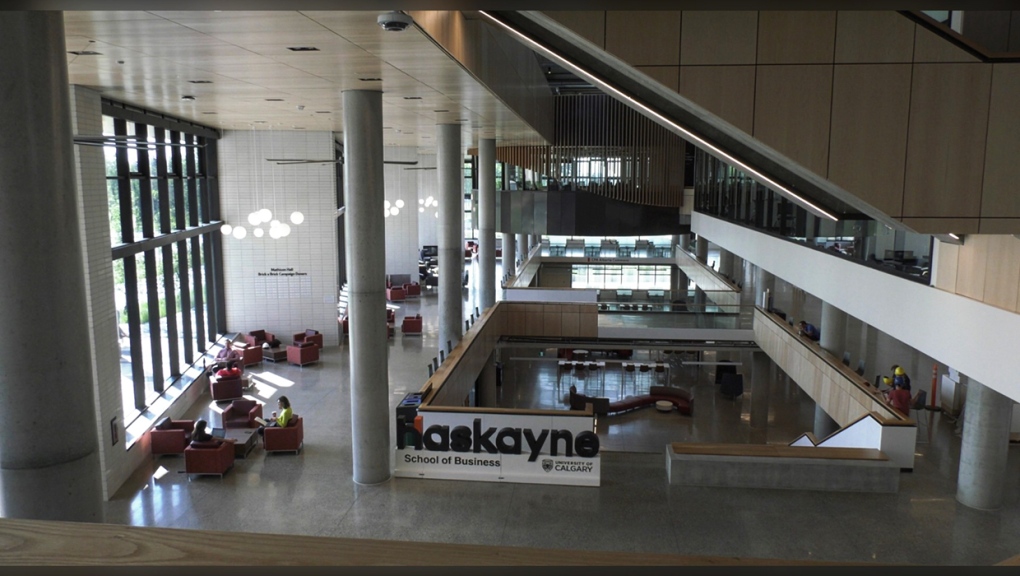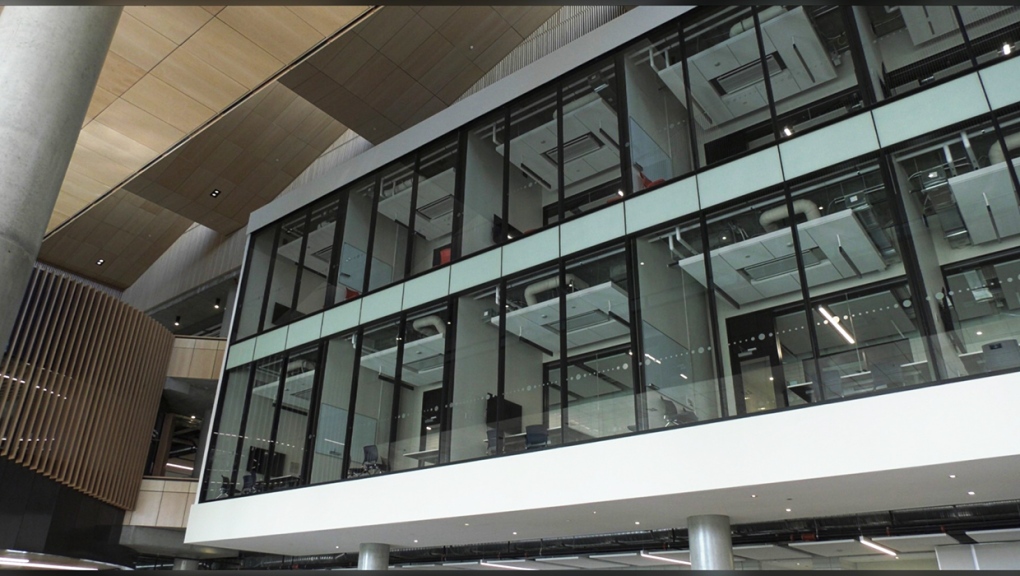U of C’s Mathison Hall aims to set precedent for future green energy learning spaces
A new building at the University of Calgary is targeting the highest level of environmental design certifications as it aims to set a precedent for developing future green energy learning spaces across the country.
Mathison Hall is a four-storey, 10,000 square-metre facility that opened its doors at the Haskayne School of Business in January as an attachment to the existing Scurfield Hall.
The building from architecture firm Diamond Schmitt features 12 technology-enhanced classrooms, an 80-person open-concept room, and ample spaces for students to work and socialize, but it also doubles as its own sustainability lab on campus.
Travis Perry, director of business development and pre-construction with EllisDon said the building uses recycled content and sustainability sourced wood.
He added that low-emitting materials were also used throughout the construction process to reach a platinum level of LEED certification (Leadership in Energy and Environmental Design).
“It’s also been a tremendous amount of work to figure out what the orientation of this building needs to be to maximize on light and solar gain," Perry said. "It’s maybe something we take for granted just standing here in a big hall, but a lot of science is behind this.”
Some of the most prominent environmental impacts noticed so far are as follows:
- Reducing indoor water use by over 50 per cent using low-flow fixtures
- Reducing building energy use by over 42 per cent
- Diverting over 75 per cent of construction waste from landfills
- Reducing heat island effect (higher temperatures due to more people around)
The building has a rainwater collection system that circulates water for toilets and urinals which helps to dramatically reduce usage.
A cascading heating and cooling system shared with the adjacent Scurfield Hall also dramatically reduces energy usage.
“The discharge water from Scurfield Hall becomes the supply water for Mathison Hall and we’re actually recycling that water to heat this building and cool this building prior to going back to the central plant on campus,” said Perry.
A special ‘double façade’ on the south end of the building is also utilized to save energy as needed.
“A double façade is a gap in between the exterior and interior of the building and we can take the heat that’s generated by the sun and use it to our benefit or shed it if we don’t need to.”
“In the summertime, we have the ability to shed that light from coming through the wall, but in the winter time we can actually take that energy from the sunlight and bring it into the building to reduce the amount of energy we need to create by burning fossil fuels.”
Mike Van Hee, who oversees the facilities department and is the vice-president of services at the University of Calgary, said Mathison Hall is a great example of a net-zero building that can impact the future of learning and instructing on university campuses.
 The $90 million Mathison Hall capital project was first announced in 2018 and made possible through a $20 million donation from Ronald P. Mathison, a Calgary business leader and chairman of MATCO Group.
The $90 million Mathison Hall capital project was first announced in 2018 and made possible through a $20 million donation from Ronald P. Mathison, a Calgary business leader and chairman of MATCO Group.
“These buildings are going to be here for 60 to 70, maybe 100 years. They need to be functional for the needs of today but also meet the requirements of the future,” said Van Hee.
“So we don't just build them for today's building codes, we build them for the future and need this to be a document we're proud of for many years to come.
The $90 million Mathison Hall capital project was first announced in 2018 and made possible through a $20 million donation from Ronald P. Mathison, a Calgary business leader and chairman of MATCO Group.
More than 200 donors contributed to the building, with Haskayne securing more than $33.7 million towards its $40 million philanthropic goal.
ACCELERATING INNOVATIVE LOW-CARBON SOLUTIONS
The Smart Sustainable Resilient Infrastructure Association (SSRIA) is a non-profit group that provides support and growth opportunities for companies across Alberta and Canada who want to be low-carbon leaders.
According to the association, the operation of buildings accounts for nearly 20 per cent of greenhouse gas emissions in Canada and as high as two-thirds of emissions in Alberta’s largest cities
It’s why SSRIA’s goal is to accelerate the adoption of innovate solutions to reduce greenhouse gas emissions from the built environment to reach net-zero emissions by 2050.
Manager of Industry Relations Daniel Benner said his team is now moving the industry ‘beyond business as usual’ by funding and validating innovative low carbon solutions through demonstrable projects.
These include new technologies, products and processes that are highly replicable through the use of artificial intelligence and energy storage processes
“So these technologies, they vary, quite broadly, ranging from the implementation of smart switches and controls on new construction projects, all the way to deep energy retrofits on existing buildings,” Benner said.
 Low-emitting materials were also used throughout the construction process to reach a platinum level of LEED certification (Leadership in Energy and Environmental Design).
Low-emitting materials were also used throughout the construction process to reach a platinum level of LEED certification (Leadership in Energy and Environmental Design).
“How a building performs and how it’s constructed will obviously be a result of how it operates at the end of the day with choosing different mechanical systems and so on. These projects like Mathison Hall provide a lot of validation for high performance buildings, especially in the local context, being in a cold climate, it's really important to be to focus on that.”
Benner aded that many of the SSRIA demonstration projects in Calgary across Alberta happen to be for residential buildings right now, but low carbon technologies are expanding to much larger scale facilities as well.
“Educational institution buildings are a great place to do demonstrations because their ownership model makes them more focused on reducing operational costs through efficiency,” he said.
“It really shows that institutions like the U of C are changing their perspectives and looking from a long-term resiliency perspective.”
CTVNews.ca Top Stories

opinion Tom Mulcair: Prime Minister Justin Trudeau's train wreck of a final act
In his latest column for CTVNews.ca, former NDP leader and political analyst Tom Mulcair puts a spotlight on the 'spectacular failure' of Prime Minister Justin Trudeau's final act on the political stage.
B.C. mayor gets calls from across Canada about 'crazy' plan to recruit doctors
A British Columbia community's "out-of-the-box" plan to ease its family doctor shortage by hiring physicians as city employees is sparking interest from across Canada, says Colwood Mayor Doug Kobayashi.
'There’s no support': Domestic abuse survivor shares difficulties leaving her relationship
An Edmonton woman who tried to flee an abusive relationship ended up back where she started in part due to a lack of shelter space.
opinion King Charles' Christmas: Who's in and who's out this year?
Christmas 2024 is set to be a Christmas like no other for the Royal Family, says royal commentator Afua Hagan. King Charles III has initiated the most important and significant transformation of royal Christmas celebrations in decades.
Baseball Hall of Famer Rickey Henderson dead at 65, reports say
Rickey Henderson, a Baseball Hall of Famer and Major League Baseball’s all-time stolen bases leader, is dead at 65, according to multiple reports.
Arizona third-grader saves choking friend
An Arizona third-grader is being recognized by his local fire department after saving a friend from choking.
Germans mourn the 5 killed and 200 injured in the apparent attack on a Christmas market
Germans on Saturday mourned the victims of an apparent attack in which authorities say a doctor drove into a busy outdoor Christmas market, killing five people, injuring 200 others and shaking the public’s sense of security at what would otherwise be a time of joy.
Blake Lively accuses 'It Ends With Us' director Justin Baldoni of harassment and smear campaign
Blake Lively has accused her 'It Ends With Us' director and co-star Justin Baldoni of sexual harassment on the set of the movie and a subsequent effort to “destroy' her reputation in a legal complaint.
Oysters distributed in B.C., Alberta, Ontario recalled for norovirus contamination
The Canadian Food Inspection Agency has issued a recall due to possible norovirus contamination of certain oysters distributed in British Columbia, Alberta and Ontario.

































